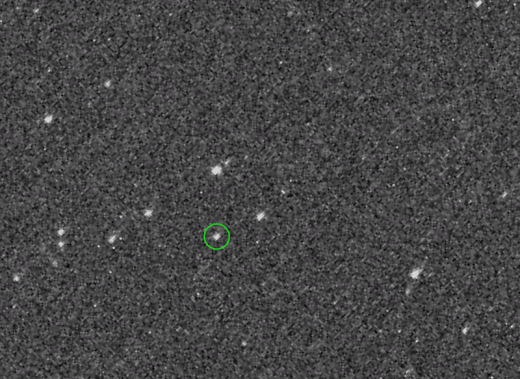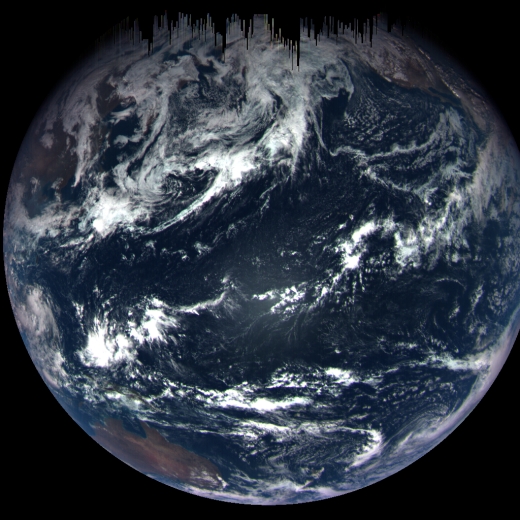The OSIRIS-REx spacecraft carries three cameras as it makes its way to the asteroid called Bennu, a suite that is collectively known as the OSIRIS-REx Camera Suite (OCAMS). So now we’re into the realm of OSIRIS-REx acronyms, and these should become familiar in coming months just as New Horizons’ instruments like LORRI (Long Range Reconnaissance Imager) and PEPSSI (Pluto Energetic Particle Spectrometer Science Investigation) did enroute to Pluto.
The camera called PolyCam is responsible for the image below, an animation showing the target acquired on August 17, at a distance of 2.25 million kilometers. PolyCam will serve as a reconnaissance camera as the spacecraft nears Bennu, but its other role is that illustrated here, as a long-range acquisition camera whose first visual of the target has been in the works for nine weeks. That’s the length of the planning process, testing, reviews and code upload.
“Right now, Bennu just looks like a star, a point source,” said Carl Hergenrother, UA Lunar and Planetary Laboratory staff scientist and OSIRIS-REx astronomy working group lead who proposed Bennu as the mission target during the early planning phase when the asteroid was simply known as 1999 RQ36. “That will change in November, when we will begin detailed observations and we’ll start seeing craters and boulders. You could say that’s when our asteroid will transition from being an astronomical object to an actual geological object.”

Image: For this animation, OSIRIS-REx image scientists combined five exposures of asteroid Bennu taken by the spacecraft’s PolyCam camera. At this distance, almost six times of that between the Earth and the moon, Bennu is just a point source, indistinguishable from a star other than the way it moves against the star field in the background. This will change dramatically once the spacecraft comes closer and makes its rendezvous with the asteroid in December. Credit: NASA/Goddard/University of Arizona.
We’re 98 days from arrival at Bennu on December 3. OSIRIS-REx controllers will be increasingly busy as the approach phase intensifies, as a glance at the approach activities shows. Here’s what’s ahead during this period, as presented in an LPL news release:
- Regularly observe the area around the asteroid to search for dust plumes and natural satellites, and study Bennu’s light and spectral properties;
- Execute a series of four asteroid approach maneuvers, beginning on Oct. 1, slowing the spacecraft to match Bennu’s speed and trajectory;
- Jettison the protective cover of the spacecraft’s sampling arm in mid-October and subsequently extend and image the arm for the first time in flight;
- Use OCAMS to reveal the asteroid’s overall shape in late October and begin detecting Bennu’s surface features in mid-November.
As for the rest of those acronyms beyond the OCAMS camera suite, we will be hearing more and more about a thermal spectrometer (OTES), the OVIRS visible and infrared spectrometer, the OLA laser altimeter and the REXIS X-ray spectrometer. On the OSIRIS-REx acronym itself, we can untangle it this way: Origins Spectral Interpretation Resource Identification Security Regolith Explorer.
Quite a mouthful, but it does condense the mission goals: To return a sample of a carbon-rich asteroid, define its properties, identify its chemistry and mineralogy, measure the Yarkovsky Effect on nearby asteroids (caused by uneven heating on a rotating asteroid, and capable of changing an asteroid trajectory), and document the morphology, geochemistry and spectral properties of the surface material. Along the way, we’ve already had some spectacular views.

Image: A color composite image of Earth taken on Sept. 22 by the MapCam camera on NASA’s OSIRIS-REx spacecraft. This image was taken just hours after the spacecraft completed its Earth Gravity Assist at a range of approximately 170,000 kilometers. MapCam is part of the OSIRIS-REx Camera Suite (OCAMS) operated by the University of Arizona. Visible in this image are the Pacific Ocean and several familiar land masses, including Australia in the lower left, and Baja California and the southwestern United States in the upper right. The dark vertical streaks at the top of the image are caused by short exposure times (less than three milliseconds). Short exposure times are required for imaging an object as bright as Earth, but are not anticipated for an object as dark as the asteroid Bennu, which the camera was designed to image. Date Taken: Sept. 22, 2017. Instrument Used: OCAMS (MapCam). Credit: NASA/Goddard/University of Arizona.
The peoples of the ancient Nile delta saw the Egyptian god Osiris as being behind the spread of agriculture, therefore considering this deity to be a bringer of life. Thus the determination to come up with the name OSIRIS in this mission. After all, OSIRIS-REx will be returning samples of the kind of asteroid that may contain organics. Ultimately, the origin of life on our planet may be tied into delivery of materials from such asteroids, so the name seems appropriate.
Bear in mind that for all its interest, Bennu is a tiny world, no more than 500 meters in diameter. That will make Bennu the smallest object ever orbited by a spacecraft. OSIRIS-REx will map the asteroid in its first month after arrival, allowing for the first direct measurement of its mass. Sample collection is scheduled to begin in early July 2020, with the spacecraft returning to Earth to eject its Sample Return Capsule for a landing in the Utah desert in September, 2023.
“The story of this asteroid is the story of the solar system,” says OCAMS instrument scientist Bashar Rizk. “When we understand Bennu, we will understand something fundamental about our solar system.”
Meanwhile, we continue to monitor the Japanese Hayabusa 2 spacecraft, which arrived at asteroid Ryugu in late June, and on which controllers have chosen a landing site. The spacecraft’s lander, the Mobile Asteroid Surface Scout (MASCOT), is scheduled to touch down on October 3 as part of the sample-return mission. More on Hayabusa 2 soon as we continue the exploration of near-Earth objects not only for the insights they give us into the early Solar System but also their potential for resource extraction and our need for planetary protection.



For all the talk about how humans would make for more efficient sample collectors, all the interesting exploration and sample collecting is being done by robotic probes. Bennu’s surface will be thoroughly mapped and the small sample returned for more sophisticated analysis on Earth.
While the mission is not cheap, we can expect both cheaper and more capable craft eventually to follow, preferably in droves, mapping and sampling the whole system, out to the Kuiper belt and perhaps eventually to the Oort cloud. By then we may even be getting flyby images of exoplanets around the nearer stars.
For all its sophistication, OSIRIS-Rex is still a “dumb” probe, requiring control from Earth. At some point, probes will start to transition to using onboard AI systems to manage the mission objectives. When that happens, Clarke’s vision of a crewed ship with an onboard AI, will appear in an evolved, smaller form, much as computers evolved from using vacuum tubes to transistors to integrated circuits. Those future HALs will be unencumbered by human crews, interacting with remote human and machine managers for mission updates, while fully controlling the probes tasks locally, perhaps in concert with its swarm brethren.
HAL for the win
It may be the other way around by then! Just watched Extinction (2018).
I wasn’t going to watch that movie, but you piqued my interest. It was better than I expected. Definite elements of “The Tunnel Under the World” and “Imposter”.
To Paul; a question on the earth space picture in the article above:
Paul, can you tell me is the picture that is taken by that particular space probe that you’re talking about in the article that is of the earth, is that picture at the normal optical capabilities of the lens that they have on board, or is that a picture that was taken and underwent enlargement to bring out the detail of our globe ?
I often wonder, because I’ve seen other pictures from manned and unmanned craft which show unusually high resolution and I wonder if that resolution is the direct product of some type of computer enhancement or if that is a photograph that is at the optic systems normal capabilities.
Do you have any information on that, just wondering?
I’m afraid I have no further information about how the image was processed, but I’ll see what I can find out.
Another question I just thought of, about the following statement:
“This image was taken just hours after the spacecraft completed its Earth Gravity Assist at a range of approximately 170,000 kilometers. ”
To the gravity assist occur at 170,000 kilometers, or was the picture taken at that distance, and the gravity assist occurred at a closer distance to the earth ?
‘To the gravity assist …’, Meant to say, ‘did the gravity assist ‘; sorry about that…
Ther gravity assist maneuver would take place both before and after closest approach. I think what they mean is that after [most of ] the assist, the pic was taken on the outward leg of the trajectory.
It’s striking that the probe is only six times further away from its target than our moon is from us — yet we’re still 98 days away from arrival! This suggests a relatively slow approach, as I guess is necessary to enter orbit around such a small body? Will it “land”, or just match velocity and stick its robot arm out with a digging implement?
I had the same thought. If the asteroid is only 500 meters in diameter, then it has a very weak gravity field, and the orbital velocity of the spacecraft will be very slow.
Answering my own question from my previous comment: the probe will touch the asteroid for just 5 seconds! (and up to 3 attempts). There is a cool animation of the process here:
https://www.asteroidmission.org/mission/#sample
OSIRIS-REx and New Horizons catch first sight of their targets
http://www.planetary.org/blogs/emily-lakdawalla/2018/0829-osiris-rex-and-new-horizons-first-light.html